Polwarth is a breed of sheep that was developed in Victoria, Australia in 1880. They were of one-quarter Lincoln and three-quarters Merino bloodlines. They are large, predominantly polled sheep with long, soft, fine wool and produce good meat carcasses. They were developed in an attempt to extend the grazing territory of the sheep because the Merino was found lacking in hardiness in this respect. They are a dual-purpose breed with a major emphasis on wool production. Richard Dennis of Tarndwarncoort in southwest Victoria bred the Polwarth, first known as Dennis Comebacks. Descendants of Dennis' sheep continue to grow Polwarth wool at Tarndwarncoort, maintaining the original bloodlines in a flock referred to as the "Blue Dots".

The Cotswold is a British breed of domestic sheep. It originates in, and is named for, the Cotswold hills of the southern midlands of England. It is a large long-woollen sheep, and is kept as a dual-purpose breed, providing both meat and wool.

The Navajo-Churro, or Churro for short, is a breed of domestic sheep originating with the Spanish Churra sheep obtained by the Diné around the 16th century during the Spanish Conquest. Its wool consists of a protective topcoat and soft undercoat. Some rams have four fully developed horns, a trait shared with few other breeds in the world. The breed is highly resistant to disease. Ewes often birth twins, and they have good mothering instincts. This breed is raised primarily for wool, although some also eat their meat.
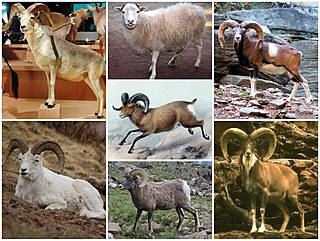
Ovis is a genus of mammals, part of the Caprinae subfamily of the ruminant family Bovidae. Its seven highly sociable species are known as sheep or ovines. Domestic sheep are members of the genus, and are thought to be descended from the wild mouflon of central and southwest Asia.

The Jacob is a British breed of domestic sheep. It combines two characteristics unusual in sheep: it is piebald—dark-coloured with areas of white wool—and it is often polycerate or multi-horned. It most commonly has four horns. The origin of the breed is not known; broken-coloured polycerate sheep were present in England by the middle of the seventeenth century, and were widespread a century later. A breed society was formed in 1969, and a flock book was published from 1972.

The Romney, formerly called the Romney Marsh sheep but generally referred to by the local farmers as the Kent, is a breed of sheep originating in England. The Romney is a "long-wool" breed recognized in England by 1800. Exported to other continents, the Romney is an economically important sheep breed, especially to the sheep-meat and wool export trades of New Zealand.
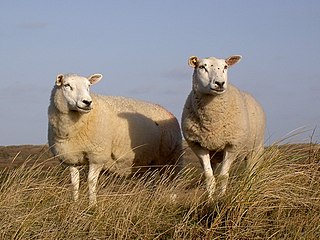
The Texel is a Dutch breed of domestic sheep originally from the island of Texel. It is a heavy and muscular sheep, and produces a lean meat carcass. It is polled, clean-faced and clean-legged, with white face and wool. The fibre diameter of the wool averages about 32 μ, with a staple length of 8–15 cm; it is used mainly for knitting and hosiery wools.
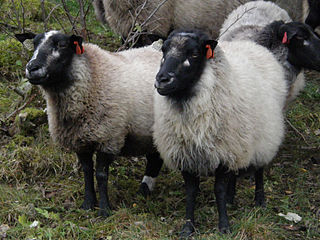
The Norwegian Grey Troender is a very rare breed of domesticated sheep that originated from crossbreeding native landrace sheep with the now extinct Tautra sheep in the late 19th century. There are currently approximately 50 individual animals, nearly all residing within Norway.

Welsh Mountain sheep are small, hardy sheep from the higher parts of the Welsh mountains. The males have horns, and the females are polled (hornless); they have no wool on the face or legs, and they have long tails. There are a number of varieties, bred for sheep farming in Wales. These are mainly colour variations, but some are being developed as separate breeds.
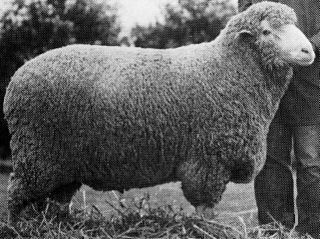
Bond sheep are an Australian sheep breed that was developed around 1909 near Lockhart, New South Wales by Thomas Bond when he mated Saxon-Peppin Merino ewes to stud Lincoln rams for primarily wool production. The resulting progeny was selected on the basis that they would be more suited to the Riverina environment. Initially these sheep were known as ‘the Commercial Corriedale’.
The Debouillet is a breed of domestic sheep originating from Tatum, New Mexico. It was developed in the 1920s through crossing Rambouillet and Delaine Merino sheep and the breed's name is a portmanteau of these two ancestors. This breed is primarily raised for its wool.
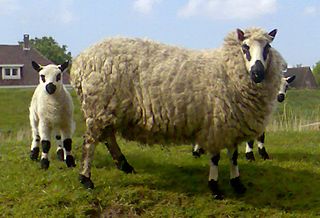
The Kerry Hill is a breed of domestic sheep originating in the county of Powys in Wales. It derives its name from the village of Kerry (Ceri), near Newtown. Kerry Hill sheep have a distinctive and unique coloration, with a white face bearing black markings around the mouth, ears, and eyes. Both rams and ewes are polled. Their wool is white, and their legs are white with black markings. First mentions of the breed date back to the early 19th century, and today it is distributed throughout the United Kingdom, Ireland, the Netherlands, Germany and Denmark. Though still not very numerous, the breed was removed from the records of the Rare Breeds Survival Trust watchlist in 2006. This breed is primarily raised for meat.

The Racka or Hortobágy Racka Sheep is a breed of sheep known for its unusual spiral-shaped horns. These unique appendages are unlike any other domestic sheep horns, and may grow up to 2.0 ft (0.61 m) long. The smallest standard length is 20 in (51 cm) for rams and 12–15 in (30–38 cm) for ewes.

The Llanwenog is a breed of domestic sheep originating in Wales. It was developed in the 19th century from the Llanllwni, the Shropshire, Welsh Mountain, and Clun Forest breeds. The Llanwenog's native locale is the Teifi Valley, in western Wales, but it has since spread into other areas. The breed association was formed in 1957. Llanwenogs have black faces and medium-length wool. They have a docile temperament and are known for their profligacy in lambing. The breed has a very placid temperament, is easily handled, easily contained and is well suited to stress free inwintering if necessary. This has important consequences for the health of both the animal and its keeper. This breed is raised primarily for meat.

The Zwartbles is a breed of domestic sheep originating in the Friesland region of the north Netherlands. There it was primarily used for the production of sheep milk as well as lamb and mutton. They were often kept alongside dairy cattle herds.
The Devon Closewool is a British breed of domestic sheep. It is distributed almost exclusively on Exmoor in North Devon, in south-west England. It is raised primarily for meat.

The Beulah Speckled Face is a breed of domestic sheep originating in the United Kingdom. Having been bred in the uplands of Wales for more than a hundred years, a breed society was officially formed in 1958. This breed is most common in Eppynt, Llanafan Fawr, Abergwesyn, and Llanwrtyd Wells, and it is little known outside Wales. The origins of the breed are unclear; it may be a truly native breed that has been selected to suit the local environment for centuries. The breed is named for its distinctly patterned black and white face, which is free from wool. The ewes, which are naturally polled, are often crossed with lowland rams such as the Suffolk, Texel or Bluefaced Leicester to breed mules, and to produce market lambs for meat. When bred pure, the lambs do not meet today's export demand for lean, fast-growing sheep. However, the ewes make good mothers and produce plenty of milk.

The Bentheimer Landschaf is a breed of domesticated sheep found in Germany. This breed is a cross between German and Dutch heath sheep and a marsh sheep. It is primarily used for landscape preservation.
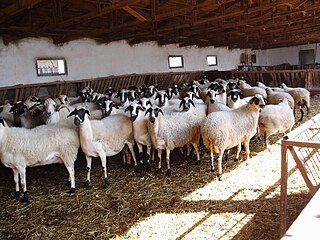
The Chios is a breed of domestic sheep with specific unknown origins. It is classified as a semi-fat tailed breed. The Chios are bred mainly for their milk production. Although there is speculation that this breed may have been crossed with Kivircik and Dagliç, it is commonly accepted that it originated on the Greek island of Chios.
Edilbay sheep, also known as Edilbaev(skaya) sheep, are a breed of domesticated sheep which originated in northern Kazakhstan. This breed belongs to the coarse-wooled fat-tailed type of sheep and the Kazakh group. It originated in the 19th century as a cross between Kazakh fat-tailed sheep and Kalmyk/Astrakhan coarse-wooled sheep. Today, it is found in Kazakhstan and Russia.
















